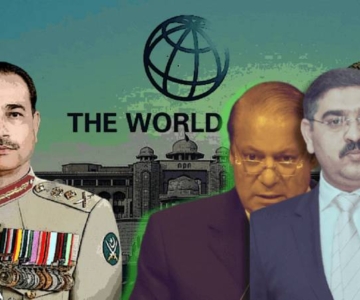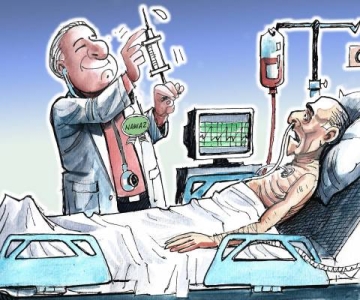Notwithstanding Pakistan’s internal challenges or the ‘war on terror’ in its backyard, the troubled relationship with India continues to drive its internal and external policies. Pakistan’s mighty military is essentially trained to counter the bigger neighbour and imagines India to be the greatest threat.
In recent years, there have been signs of some shifts in military’s worldview but these shifts are yet to filter down into the institutional structures: the way strategic calculations are made and ‘threat perception’ is determined. Despite these structural constraints, the political elites have resolved to undo the bitter legacy of the past and push for improved trade ties and continued dialogue with the archenemy. At times the enthusiasm of Pakistani politicians appears to be at variance with the views of Indian political class, which seems divided on how to transact this bilateral relationship.
Since the election of Nawaz Sharif as the Prime Minister in June 2013, domestic terrorism and skirmishes at the Line of Control (LoC) have prevented any major development to take place. In fact by the end of 2013, many feared that the modest gains (trade and visa liberalization) made in the past few years had been reversed due to the continued hostilities at the border.
The domestic political environment in India has also become much more charged and jingoistic in view of the upcoming May 2014 elections. Yet, the meeting of the respective DGMOs in December was most reassuring in which they resolved to undertake joint patrolling of the LoC and meet more frequently. It is noteworthy that the two senior officials of the respective armies met after a gap of 14 years.
In Pakistan, Nawaz Sharif remains the most formidable political voice for normalizing ties with India. During the past seven months, not once he let Indian jingoistic signals affect his resolve. In part Sharif is driven by the quest to moderate the military’s hegemony in domestic affairs. More importantly, his stance reflects the priroties of the powerful business lobbies within Pakistan that want increased trade with India as it will benefit a wide range of manufacturers, traders and investors. Sharif is not just an advocate of this huge network; he enjoys their electoral support and shares similar aspirations.
In the context, the January 2014 meeting of the Commerce ministers of Pakistan and India and the agreement to provide each other Non-Discriminatory Market Access (NDMA) is a landmark step. The Ministers also agreed to allow 24 hours non-stop movement of trucks and containers through the Wagah-Attari land route. Further liberalistion of visa regime for businessmen was also agreed. NDMA actually resolves the pending issue of granting the Most Favoured Nation (MFN) status to India (which the latter has already granted to Pakistan). The nomenclature, MFN, with the word ‘favourite’ sadly has become an object of ridicule and criticism by extremist organisations.
The real success of ministerial parleys was the announcement that both countries would allow opening of bank branches thereby removing a major hurdle. By granting banking licenses, India and Pakistan would enable greater trade volume and investment opportunities. Experiences from other regions of the world demonstrate that trade and investment are the best guarantors and enablers of peace. The two nuclear nations have wasted enough time in the past and squandered many opportunities for building peace.
Media reports also suggest that during January discussions, the ministers agreed that both sides will organize meetings of technical working groups in fields such as Customs, Railways, Banking, Standards and Energy for improving the bilateral trade regime.
Given that such policy issues are getting traction in India during its feverish election season defies the conventional wisdom that not much progress can be achieved until Indian election process is completed and a new government takes oath later this year. At the same time it is clear that on disputes such as Jammu & Kashmir, Siachen etc., no breakthrough can be expected during the transition of power from one government to another in India.
The most obvious question raised by all and sundry relates to military’s view of the trade-ties and whether it was willing to allow for economic ties beyond ‘reasonable limits’? This is a difficult question and only time will tell whether there is any change in the old doctrines of the Pakistan Army that has always been wary of ‘expansionist’ designs of India. Again the business lobbies have played a major role in sensitizing the military leadership on why trade is vital for Pakistan’s economic growth. With a change in army leadership during November 2014, it is somewhat easier for Sharif to reset regional ties in a post-Musharraf-Kayani Pakistan. He is gradually attempting to take charge of the key policies and has started the realignment of foreign policy priorities by focusing on trade with India.
India-Pakistan trade volume, since 2011, has shown considerable improvement. It has crossed the $3bn mark, almost a 30% increase within two years. The estimated potential of trade volume is over $10bn and this does not include the energy trade for which Pakistan can be a regional hub if Afghanistan stabilizes beyond 2014.
This brings us to the flashpoint, which will impact India-Pakistan relations in the short to medium term, i.e., Afghanistan. Both countries are competing for influence in Afghanistan and unless they don’t normalize bilateral ties, misgivings and suspicions over Afghanistan could erupt into a heightened conflict. This is why India and Pakistan need to enter into a meaningful dialogue on Afghanistan and allay mutual fears.
While the two states continue to work through archaic bureaucratic structures, the private sector is showing far more commitment. Trade delegations from both counties are visiting. The Joint Business Forum of Chief Executive Officers in different sectors also met in the recent months. Sub-groups (representing various economic sectors) of the Joint Business Forum have also been formed to achieve clarity and enhanced cooperation.
India’s non-tariff barriers and Pakistan’s negative list remain key impediments to the future roadmap. Pakistan’s government, some critics say, is not well equipped with the capacity to weave and manage complex trade relations. At the same time some industries in Pakistan such as agriculture, pharmaceuticals and the auto (spare parts) are not too keen for the country to phase out the negative list. Fear of flooding and inherent uncompetitiveness of these industries may come to light. These concerns would need to be addressed by Sharif administration.
Most economists agree that trade is the best way to enhance economic growth in the short term. If one adds the gains to be made in political and strategic domains, then Nawaz Sharif’s policy choices appear to be rather astute.



